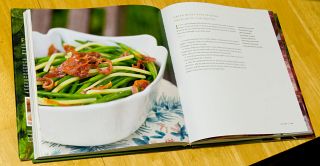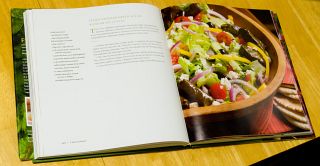
The book starts off with a 28 page primer on vegetables which does a good job covering the topics of how to select vegetables, what the common vegetables look like and taste like, how to store, wash, peel, and cut them, and, of course, how to cook (boil, steam, microwave, roast, bake, sauté, stir fry, pan fry, deep fry, grill, broil, stew, braise, and puree) and reheat vegetables.
Related Articles
 Vegetables then progresses onto the main section - 256 pages containing 170 recipes divided into the following sections: Soups, Appetizers, Salads, Entrees, Side Dishes, and Sauces & Relishes. Each section not only contains recipes but starts with a discussion on method and theory to help the reader understand the basic techniques of producing, let's say, a hearty soup or a stuffed vegetable. Focus pages on various topics such as vinaigrettes, mayonnaise, and specific vegetables can be found scattered throughout the book as well.
Vegetables then progresses onto the main section - 256 pages containing 170 recipes divided into the following sections: Soups, Appetizers, Salads, Entrees, Side Dishes, and Sauces & Relishes. Each section not only contains recipes but starts with a discussion on method and theory to help the reader understand the basic techniques of producing, let's say, a hearty soup or a stuffed vegetable. Focus pages on various topics such as vinaigrettes, mayonnaise, and specific vegetables can be found scattered throughout the book as well. Although most of the recipes do not have photographs, many of them do and they are beautiful full bleed, full page photos. Other pages include illustrations of particular vegetables (related to the specific recipe). The pages themselves are on heavy stock, high contrast paper securely sewn through the fold allowing the pages to lie flat. By grasping just one page, I was able to hold up the weight of the book without a problem.
Although most of the recipes do not have photographs, many of them do and they are beautiful full bleed, full page photos. Other pages include illustrations of particular vegetables (related to the specific recipe). The pages themselves are on heavy stock, high contrast paper securely sewn through the fold allowing the pages to lie flat. By grasping just one page, I was able to hold up the weight of the book without a problem.The recipes that I've tried have produced tasty results and have generally been very easy to follow. Earlier this year, I wrote up my positive experience with Vegetables' version of Ratatouille.
One last thing to note is that although not all the recipes are vegetarian, it should be fairly easy for most home cooks to modify them to be truly vegetarian.
Vegetables is available only in Hardback.
Related Articles
